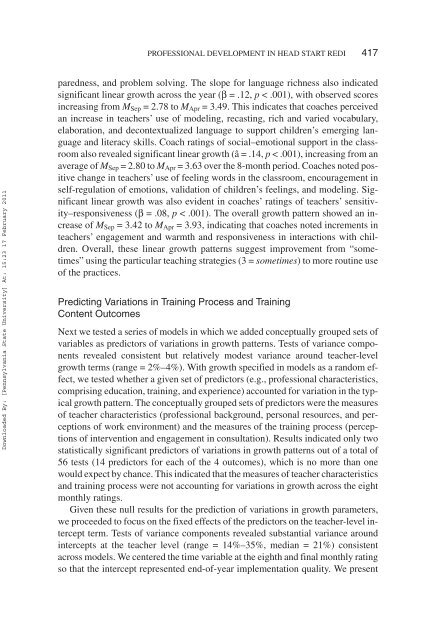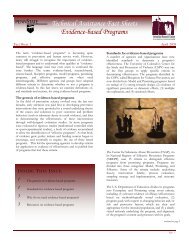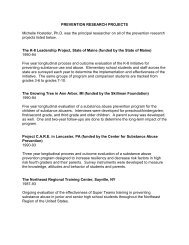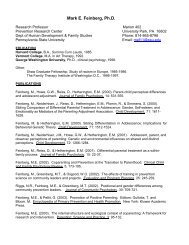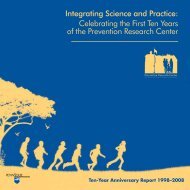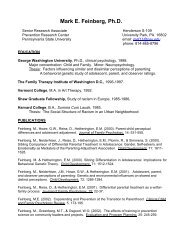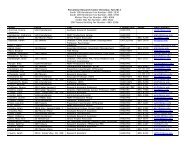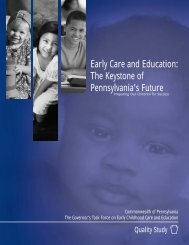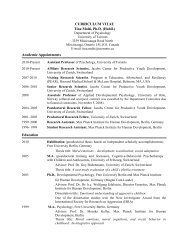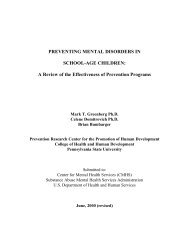Early Education & Development Individual Factors Associated With ...
Early Education & Development Individual Factors Associated With ...
Early Education & Development Individual Factors Associated With ...
You also want an ePaper? Increase the reach of your titles
YUMPU automatically turns print PDFs into web optimized ePapers that Google loves.
PROFESSIONAL DEVELOPMENT IN HEAD START REDI 417<br />
Downloaded By: [Pennsylvania State University] At: 15:23 17 February 2011<br />
paredness, and problem solving. The slope for language richness also indicated<br />
significant linear growth across the year (β = .12, p < .001), with observed scores<br />
increasing from M Sep = 2.78 to M Apr = 3.49. This indicates that coaches perceived<br />
an increase in teachers’ use of modeling, recasting, rich and varied vocabulary,<br />
elaboration, and decontextualized language to support children’s emerging language<br />
and literacy skills. Coach ratings of social–emotional support in the classroom<br />
also revealed significant linear growth (â = .14, p < .001), increasing from an<br />
average of M Sep = 2.80 to M Apr = 3.63 over the 8-month period. Coaches noted positive<br />
change in teachers’ use of feeling words in the classroom, encouragement in<br />
self-regulation of emotions, validation of children’s feelings, and modeling. Significant<br />
linear growth was also evident in coaches’ ratings of teachers’ sensitivity–responsiveness<br />
(β = .08, p < .001). The overall growth pattern showed an increase<br />
of M Sep = 3.42 to M Apr = 3.93, indicating that coaches noted increments in<br />
teachers’ engagement and warmth and responsiveness in interactions with children.<br />
Overall, these linear growth patterns suggest improvement from “sometimes”<br />
using the particular teaching strategies (3 = sometimes) to more routine use<br />
of the practices.<br />
Predicting Variations in Training Process and Training<br />
Content Outcomes<br />
Next we tested a series of models in which we added conceptually grouped sets of<br />
variables as predictors of variations in growth patterns. Tests of variance components<br />
revealed consistent but relatively modest variance around teacher-level<br />
growth terms (range = 2%–4%). <strong>With</strong> growth specified in models as a random effect,<br />
we tested whether a given set of predictors (e.g., professional characteristics,<br />
comprising education, training, and experience) accounted for variation in the typical<br />
growth pattern. The conceptually grouped sets of predictors were the measures<br />
of teacher characteristics (professional background, personal resources, and perceptions<br />
of work environment) and the measures of the training process (perceptions<br />
of intervention and engagement in consultation). Results indicated only two<br />
statistically significant predictors of variations in growth patterns out of a total of<br />
56 tests (14 predictors for each of the 4 outcomes), which is no more than one<br />
would expect by chance. This indicated that the measures of teacher characteristics<br />
and training process were not accounting for variations in growth across the eight<br />
monthly ratings.<br />
Given these null results for the prediction of variations in growth parameters,<br />
we proceeded to focus on the fixed effects of the predictors on the teacher-level intercept<br />
term. Tests of variance components revealed substantial variance around<br />
intercepts at the teacher level (range = 14%–35%, median = 21%) consistent<br />
across models. We centered the time variable at the eighth and final monthly rating<br />
so that the intercept represented end-of-year implementation quality. We present


